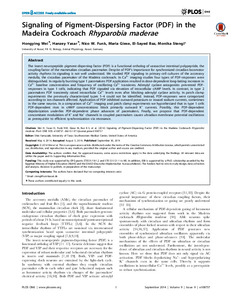Aufsatz
Artikel (Publikationen im Open Access gefördert durch die UB)

Signaling of Pigment-Dispersing Factor (PDF) in the Madeira Cockroach Rhyparobia maderae
Zusammenfassung
The insect neuropeptide pigment-dispersing factor (PDF) is a functional ortholog of vasoactive intestinal polypeptide, the coupling factor of the mammalian circadian pacemaker. Despite of PDF's importance for synchronized circadian locomotor activity rhythms its signaling is not well understood. We studied PDF signaling in primary cell cultures of the accessory medulla, the circadian pacemaker of the Madeira cockroach. In Ca2+ imaging studies four types of PDF-responses were distinguished. In regularly bursting type 1 pacemakers PDF application resulted in dose-dependent long-lasting increases in Ca2+ baseline concentration and frequency of oscillating Ca2+ transients. Adenylyl cyclase antagonists prevented PDF-responses in type 1 cells, indicating that PDF signaled via elevation of intracellular cAMP levels. In contrast, in type 2 pacemakers PDF transiently raised intracellular Ca2+ levels even after blocking adenylyl cyclase activity. In patch clamp experiments the previously characterized types 1–4 could not be identified. Instead, PDF-responses were categorized according to ion channels affected. Application of PDF inhibited outward potassium or inward sodium currents, sometimes in the same neuron. In a comparison of Ca2+ imaging and patch clamp experiments we hypothesized that in type 1 cells PDF-dependent rises in cAMP concentrations block primarily outward K+ currents. Possibly, this PDF-dependent depolarization underlies PDF-dependent phase advances of pacemakers. Finally, we propose that PDF-dependent concomitant modulation of K+ and Na+ channels in coupled pacemakers causes ultradian membrane potential oscillations as prerequisite to efficient synchronization via resonance.
Zitierform
In: PLoS one. - Lawrence, Kan. : PLoS, 2014, 9 (9), e108757, 1-13Förderhinweis
Gefördert durch den Publikationsfonds der Universität KasselSammlung(en)
Publikationen (Fachgebiet Tierphysiologie)Artikel (Publikationen im Open Access gefördert durch die UB)
Zitieren
@article{urn:nbn:de:hebis:34-2015031347727,
author={Wei, Hongying and Yasar, Hanzey and Funk, Nico W. and Giese, Maria and Baz, El-Sayed and Stengl, Monika},
title={Signaling of Pigment-Dispersing Factor (PDF) in the Madeira Cockroach Rhyparobia maderae},
year={2014}
}
0500 Oax 0501 Text $btxt$2rdacontent 0502 Computermedien $bc$2rdacarrier 1100 2014$n2014 1500 1/eng 2050 ##0##urn:nbn:de:hebis:34-2015031347727 3000 Wei, Hongying 3010 Yasar, Hanzey 3010 Funk, Nico W. 3010 Giese, Maria 3010 Baz, El-Sayed 3010 Stengl, Monika 4000 Signaling of Pigment-Dispersing Factor (PDF) in the Madeira Cockroach Rhyparobia maderae / Wei, Hongying 4030 4060 Online-Ressource 4085 ##0##=u http://nbn-resolving.de/urn:nbn:de:hebis:34-2015031347727=x R 4204 \$dAufsatz 4170 7136 ##0##urn:nbn:de:hebis:34-2015031347727
<resource xsi:schemaLocation="http://datacite.org/schema/kernel-2.2 http://schema.datacite.org/meta/kernel-2.2/metadata.xsd"> 2015-03-13T14:17:09Z 2015-03-13T14:17:09Z 2014 1932-6203 urn:nbn:de:hebis:34-2015031347727 http://hdl.handle.net/123456789/2015031347727 Gefördert durch den Publikationsfonds der Universität Kassel eng Urheberrechtlich geschützt https://rightsstatements.org/page/InC/1.0/ 570 Signaling of Pigment-Dispersing Factor (PDF) in the Madeira Cockroach Rhyparobia maderae Aufsatz The insect neuropeptide pigment-dispersing factor (PDF) is a functional ortholog of vasoactive intestinal polypeptide, the coupling factor of the mammalian circadian pacemaker. Despite of PDF's importance for synchronized circadian locomotor activity rhythms its signaling is not well understood. We studied PDF signaling in primary cell cultures of the accessory medulla, the circadian pacemaker of the Madeira cockroach. In Ca2+ imaging studies four types of PDF-responses were distinguished. In regularly bursting type 1 pacemakers PDF application resulted in dose-dependent long-lasting increases in Ca2+ baseline concentration and frequency of oscillating Ca2+ transients. Adenylyl cyclase antagonists prevented PDF-responses in type 1 cells, indicating that PDF signaled via elevation of intracellular cAMP levels. In contrast, in type 2 pacemakers PDF transiently raised intracellular Ca2+ levels even after blocking adenylyl cyclase activity. In patch clamp experiments the previously characterized types 1–4 could not be identified. Instead, PDF-responses were categorized according to ion channels affected. Application of PDF inhibited outward potassium or inward sodium currents, sometimes in the same neuron. In a comparison of Ca2+ imaging and patch clamp experiments we hypothesized that in type 1 cells PDF-dependent rises in cAMP concentrations block primarily outward K+ currents. Possibly, this PDF-dependent depolarization underlies PDF-dependent phase advances of pacemakers. Finally, we propose that PDF-dependent concomitant modulation of K+ and Na+ channels in coupled pacemakers causes ultradian membrane potential oscillations as prerequisite to efficient synchronization via resonance. open access In: PLoS one. - Lawrence, Kan. : PLoS, 2014, 9 (9), e108757, 1-13 Wei, Hongying Yasar, Hanzey Funk, Nico W. Giese, Maria Baz, El-Sayed Stengl, Monika doi:10.1371/journal.pone.0108757 </resource>
Die folgenden Lizenzbestimmungen sind mit dieser Ressource verbunden:
Urheberrechtlich geschützt

